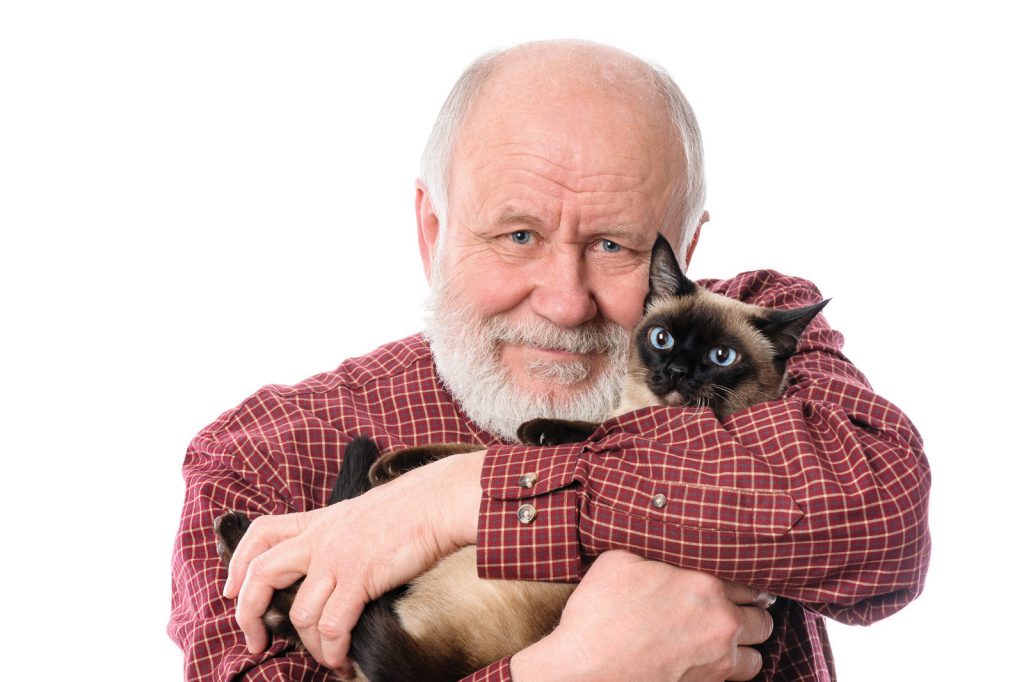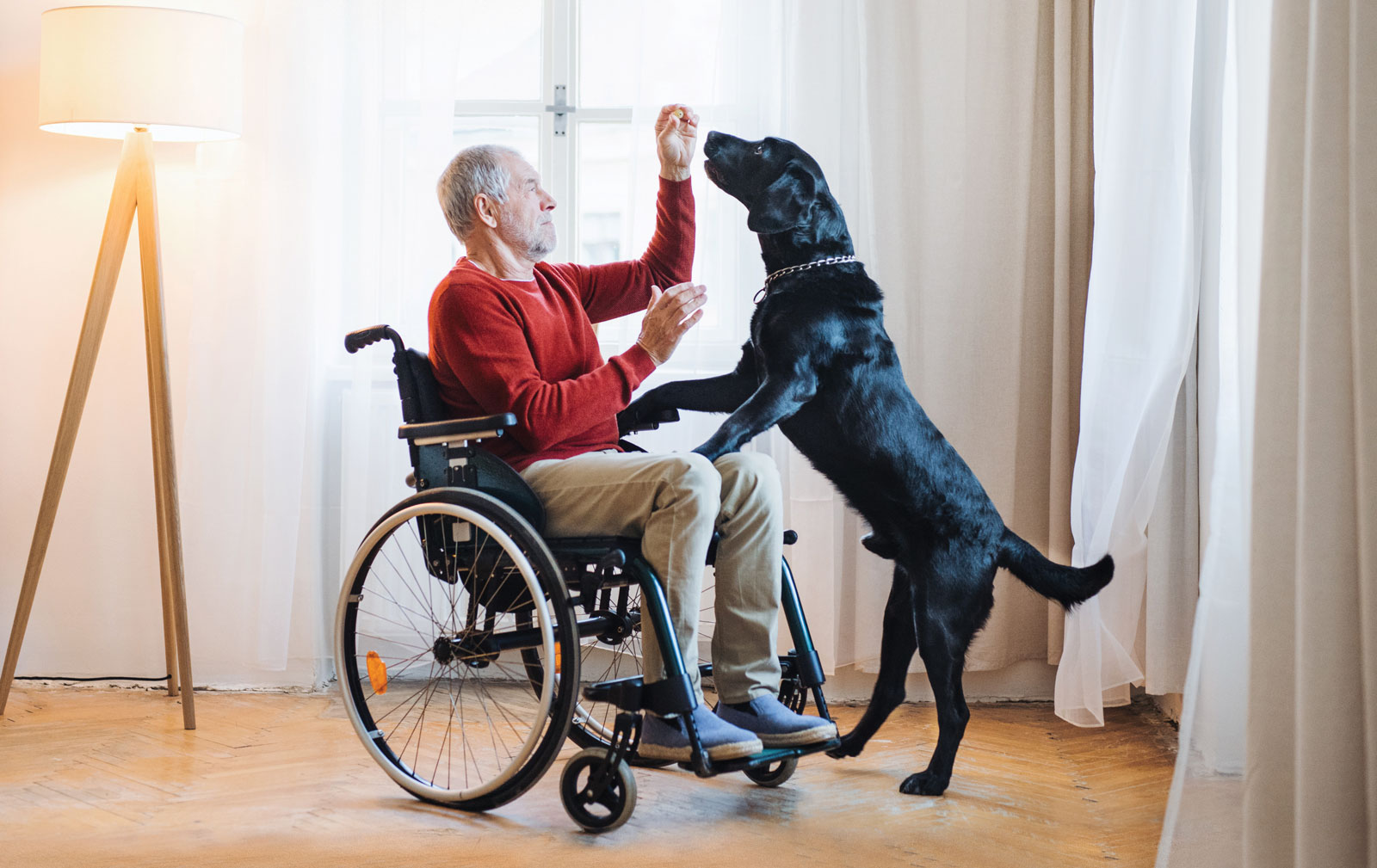By Pat Irwin
The benefits of having a pet are well-documented, and are particularly true when it comes to seniors and those who live alone.
Pet attachment has been linked to better emotional health and reduced stress, depression and psychological distress. Seniors with dogs have been shown to go to the doctor less, report fewer illnesses, have lower blood pressure and cholesterol levels, and even engage in increased social interactions with friends and neighbours.
Dog walking allows for exercise several times a day, encourages playfulness and promotes laughter. Even cats satisfy the human need for touch, caregiving and non-judgmental affection—when they’re in the mood.
That’s an impressive list! But what happens when your living circumstances change? How can seniors integrate pet ownership into their new lives?
Judy and Boris

Judy’s lifelong diabetes had always made her feel like an outsider, but her little dog Boris gave her a reason to get up every day, be among people and get to know her neighbours. As her disease progressed she knew she needed to move into a retirement community, but was wary of cliques and not being accepted. When she learned that Boris could move in too she was so happy—here was a sure-fire icebreaker and conversation starter! Then tragedy struck. Boris was diagnosed with a serious kidney problem and, to spare her pal any more pain, Judy made the terrible decision to have him put down. Without her little mascot, Judy was lost. She stayed in her room, stopped eating and began refusing medical attention.
All of this because of a dog? But Boris was more than a dog for Judy—he was an essential part of her coping strategy when it came to transitioning into her new home. Boris had provided companionship, imposed a welcome exercise routine and given Judy the unconditional love that she was so worried she’d never receive. Her fellow residents would have accepted Judy with or without her dog, but she didn’t realize that. Then, a few weeks after Boris died, a veterinary assistant called Judy to say that a four-year-old dog had been left with them after its owner had died—was she interested? She jumped at the chance and soon she and her new companion, Lilly, were back in the social whirl.
Agnes and Goldie
Agnes went to the store one morning, fell and was sent to hospital with a broken hip. A nosy neighbour, whom Agnes had never liked, cared enough to take Agnes’ German shepherd, Goldie, out of her home and to the safety of a boarding kennel. However, Agnes’ excessive worry about the dog was hindering her recovery. Goldie gave Agnes her something to care for and care about. But would she ever regain enough mobility to manage a German shepherd again?
The hospital social worker contacted Goldie’s vet, who went to visit Agnes when she returned home. The vet assured her that Goldie that she was doing fine at the kennel, and reviewed the dog’s daily routine and exercise needs. At eight years old, Goldie was a gentle dog who needed three walks a day. The vet suggested Agnes hire the dog walker who had been walking Goldie at the kennel, and who was happy to continue from Agnes’ home; other visits out the back door could be managed by Agnes on her rollator.
A new regimen of visits, dog walks and cups of tea became the focus of Agnes’s day and
her recovery.
Eric and Tootsie

Eric was a reclusive single man; his cat Tootsie was his “family” and they successfully moved into a retirement community together. Seven years later, Eric suffered a stroke and died. When his suite was being cleared out, Tootsie bolted into the garden. A week later she reappeared in the lobby but, of course, Eric was gone.
The receptionist, a cat lover, had the idea of “donating” Tootsie to the dementia floor. A bed, scratching post and toys were placed in the common area, and Tootsie eventually became bolder and friendlier. The residents were pleasantly surprised when Tootsie bounded into a lap for a visit, and she seemed to know who was lonely and needed comfort that day. Even the most reclusive residents started keeping their doors open in case the cat wanted to come in. Cat treats were kept in a bowl at the nurse’s station.
When kittens were born—a result of her short “vacation” in the garden—it was as if the residents had been electrified! Playing with the kittens, naming them, making toys, finding homes among the residents’ families and staff, even changing the litter box—nothing was too much trouble. Everyone now had a focus.
The value of pets
Pets exist in the here and now; they don’t worry about a tomorrow that might be frightening for dementia patients. Animals soothe and centre people and bring them a sense of peace. And their non-verbal communication can still be understood and appreciated by those who are no longer able to speak.
Animals also evoke long-term memories. Talking about this pet, pets from your childhood and your children’s, the animals you may have cared for on a grandparent’s farm—animals provide lots of topics to stimulate discussion, memory retention and positive associations. The cases of Judy, Agnes and Eric all demonstrate how pets benefit us, and can remain an active part of life throughout all its transitions.
“Until one has loved an animal, a part of one’s soul remains unawakened.”—Anatole France
Pat M. Irwin, BA, AICB, CPCA, is the president of ElderCareCanada and a professor of distance learning at Centennial College.













